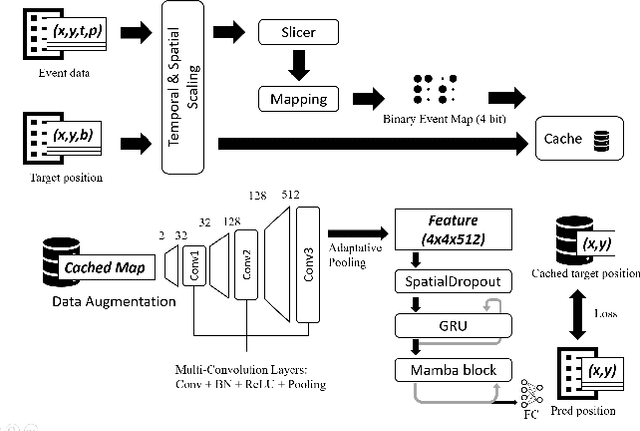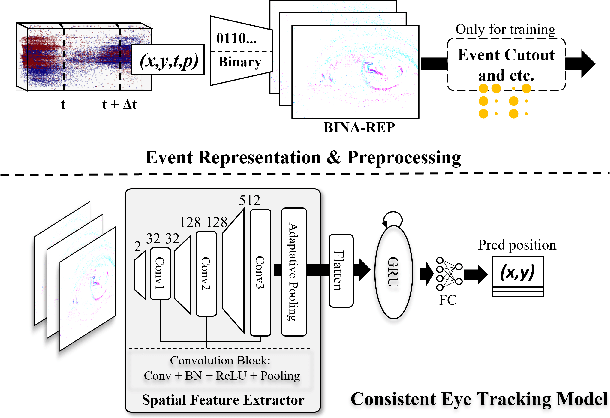Baoheng Zhang
Co-designing a Sub-millisecond Latency Event-based Eye Tracking System with Submanifold Sparse CNN
Apr 22, 2024Abstract:Eye-tracking technology is integral to numerous consumer electronics applications, particularly in the realm of virtual and augmented reality (VR/AR). These applications demand solutions that excel in three crucial aspects: low-latency, low-power consumption, and precision. Yet, achieving optimal performance across all these fronts presents a formidable challenge, necessitating a balance between sophisticated algorithms and efficient backend hardware implementations. In this study, we tackle this challenge through a synergistic software/hardware co-design of the system with an event camera. Leveraging the inherent sparsity of event-based input data, we integrate a novel sparse FPGA dataflow accelerator customized for submanifold sparse convolution neural networks (SCNN). The SCNN implemented on the accelerator can efficiently extract the embedding feature vector from each representation of event slices by only processing the non-zero activations. Subsequently, these vectors undergo further processing by a gated recurrent unit (GRU) and a fully connected layer on the host CPU to generate the eye centers. Deployment and evaluation of our system reveal outstanding performance metrics. On the Event-based Eye-Tracking-AIS2024 dataset, our system achieves 81% p5 accuracy, 99.5% p10 accuracy, and 3.71 Mean Euclidean Distance with 0.7 ms latency while only consuming 2.29 mJ per inference. Notably, our solution opens up opportunities for future eye-tracking systems. Code is available at https://github.com/CASR-HKU/ESDA/tree/eye_tracking.
Event-Based Eye Tracking. AIS 2024 Challenge Survey
Apr 17, 2024



Abstract:This survey reviews the AIS 2024 Event-Based Eye Tracking (EET) Challenge. The task of the challenge focuses on processing eye movement recorded with event cameras and predicting the pupil center of the eye. The challenge emphasizes efficient eye tracking with event cameras to achieve good task accuracy and efficiency trade-off. During the challenge period, 38 participants registered for the Kaggle competition, and 8 teams submitted a challenge factsheet. The novel and diverse methods from the submitted factsheets are reviewed and analyzed in this survey to advance future event-based eye tracking research.
MGFN: Magnitude-Contrastive Glance-and-Focus Network for Weakly-Supervised Video Anomaly Detection
Nov 28, 2022



Abstract:Weakly supervised detection of anomalies in surveillance videos is a challenging task. Going beyond existing works that have deficient capabilities to localize anomalies in long videos, we propose a novel glance and focus network to effectively integrate spatial-temporal information for accurate anomaly detection. In addition, we empirically found that existing approaches that use feature magnitudes to represent the degree of anomalies typically ignore the effects of scene variations, and hence result in sub-optimal performance due to the inconsistency of feature magnitudes across scenes. To address this issue, we propose the Feature Amplification Mechanism and a Magnitude Contrastive Loss to enhance the discriminativeness of feature magnitudes for detecting anomalies. Experimental results on two large-scale benchmarks UCF-Crime and XD-Violence manifest that our method outperforms state-of-the-art approaches.
Video Demoireing with Relation-Based Temporal Consistency
Apr 06, 2022



Abstract:Moire patterns, appearing as color distortions, severely degrade image and video qualities when filming a screen with digital cameras. Considering the increasing demands for capturing videos, we study how to remove such undesirable moire patterns in videos, namely video demoireing. To this end, we introduce the first hand-held video demoireing dataset with a dedicated data collection pipeline to ensure spatial and temporal alignments of captured data. Further, a baseline video demoireing model with implicit feature space alignment and selective feature aggregation is developed to leverage complementary information from nearby frames to improve frame-level video demoireing. More importantly, we propose a relation-based temporal consistency loss to encourage the model to learn temporal consistency priors directly from ground-truth reference videos, which facilitates producing temporally consistent predictions and effectively maintains frame-level qualities. Extensive experiments manifest the superiority of our model. Code is available at \url{https://daipengwa.github.io/VDmoire_ProjectPage/}.
 Add to Chrome
Add to Chrome Add to Firefox
Add to Firefox Add to Edge
Add to Edge